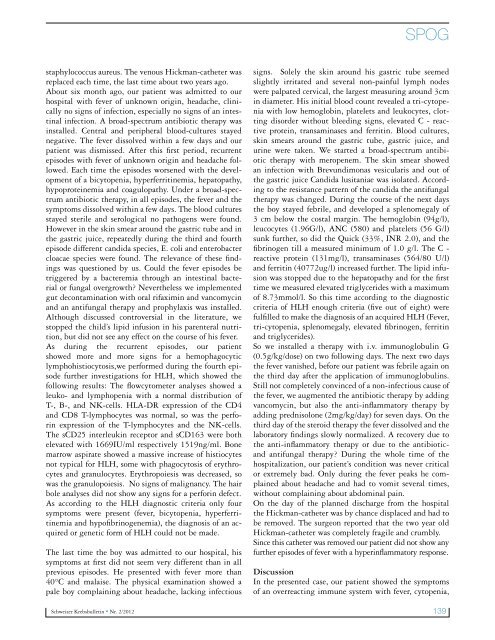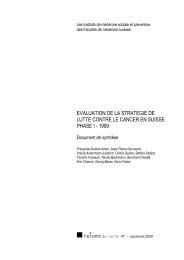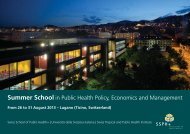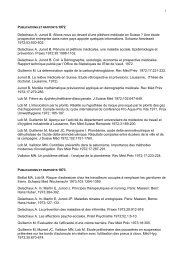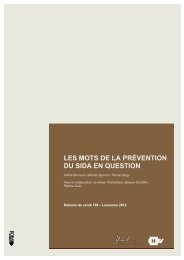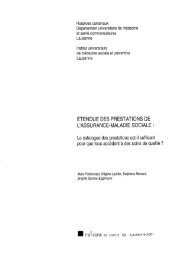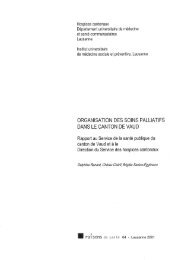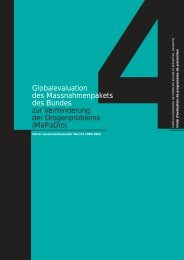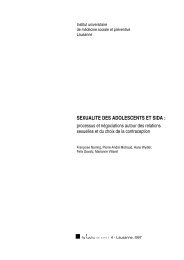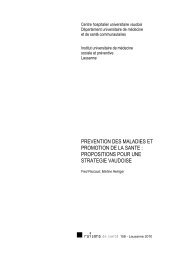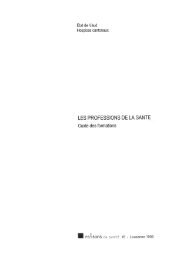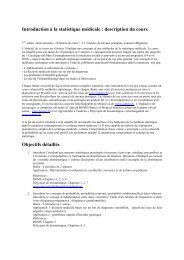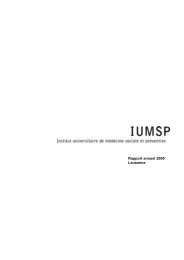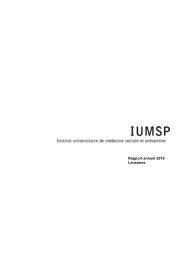Fortbildungen / Formations continues 2012 - IUMSP
Fortbildungen / Formations continues 2012 - IUMSP
Fortbildungen / Formations continues 2012 - IUMSP
Erfolgreiche ePaper selbst erstellen
Machen Sie aus Ihren PDF Publikationen ein blätterbares Flipbook mit unserer einzigartigen Google optimierten e-Paper Software.
staphylococcus aureus. The venous Hickman-catheter was<br />
replaced each time, the last time about two years ago.<br />
About six month ago, our patient was admitted to our<br />
hospital with fever of unknown origin, headache, clinically<br />
no signs of infection, especially no signs of an intestinal<br />
infection. A broad-spectrum antibiotic therapy was<br />
installed. Central and peripheral blood-cultures stayed<br />
negative. The fever dissolved within a few days and our<br />
patient was dismissed. After this �rst period, recurrent<br />
episodes with fever of unknown origin and headache followed.<br />
Each time the episodes worsened with the development<br />
of a bicytopenia, hyperferritinemia, hepatopathy,<br />
hypoproteinemia and coagulopathy. Under a broad-spectrum<br />
antibiotic therapy, in all episodes, the fever and the<br />
symptoms dissolved within a few days. The blood cultures<br />
stayed sterile and serological no pathogens were found.<br />
However in the skin smear around the gastric tube and in<br />
the gastric juice, repeatedly during the third and fourth<br />
episode different candida species, E. coli and enterobacter<br />
cloacae species were found. The relevance of these �ndings<br />
was questioned by us. Could the fever episodes be<br />
triggered by a bacteremia through an intestinal bacterial<br />
or fungal overgrowth? Nevertheless we implemented<br />
gut decontamination with oral rifaximin and vancomycin<br />
and an antifungal therapy and prophylaxis was installed.<br />
Although discussed controversial in the literature, we<br />
stopped the child’s lipid infusion in his parenteral nutrition,<br />
but did not see any effect on the course of his fever.<br />
As during the recurrent episodes, our patient<br />
showed more and more signs for a hemophagocytic<br />
lymphohistiocytosis,we performed during the fourth episode<br />
further investigations for HLH, which showed the<br />
following results: The �owcytometer analyses showed a<br />
leuko- and lymphopenia with a normal distribution of<br />
T-, B-, and NK-cells. HLA-DR expression of the CD4<br />
and CD8 T-lymphocytes was normal, so was the perforin<br />
expression of the T-lymphocytes and the NK-cells.<br />
The sCD25 interleukin receptor and sCD163 were both<br />
elevated with 1669IU/ml respectively 1519ng/ml. Bone<br />
marrow aspirate showed a massive increase of histiocytes<br />
not typical for HLH, some with phagocytosis of erythrocytes<br />
and granulocytes. Erythropoiesis was decreased, so<br />
was the granulopoiesis. No signs of malignancy. The hair<br />
bole analyses did not show any signs for a perforin defect.<br />
As according to the HLH diagnostic criteria only four<br />
symptoms were present (fever, bicytopenia, hyperferritinemia<br />
and hypo�brinogenemia), the diagnosis of an acquired<br />
or genetic form of HLH could not be made.<br />
The last time the boy was admitted to our hospital, his<br />
symptoms at �rst did not seem very different than in all<br />
previous episodes. He presented with fever more than<br />
40°C and malaise. The physical examination showed a<br />
pale boy complaining about headache, lacking infectious<br />
SPOG<br />
signs. Solely the skin around his gastric tube seemed<br />
slightly irritated and several non-painful lymph nodes<br />
were palpated cervical, the largest measuring around 3cm<br />
in diameter. His initial blood count revealed a tri-cytopenia<br />
with low hemoglobin, platelets and leukocytes, clotting<br />
disorder without bleeding signs, elevated C - reactive<br />
protein, transaminases and ferritin. Blood cultures,<br />
skin smears around the gastric tube, gastric juice, and<br />
urine were taken. We started a broad-spectrum antibiotic<br />
therapy with meropenem. The skin smear showed<br />
an infection with Brevundimonas vesicularis and out of<br />
the gastric juice Candida lusitaniae was isolated. According<br />
to the resistance pattern of the candida the antifungal<br />
therapy was changed. During the course of the next days<br />
the boy stayed febrile, and developed a splenomegaly of<br />
3 cm below the costal margin. The hemoglobin (94g/l),<br />
leucocytes (1.96G/l), ANC (580) and platelets (56 G/l)<br />
sunk further, so did the Quick (33%, INR 2.0), and the<br />
�brinogen till a measured minimum of 1.0 g/l. The C -<br />
reactive protein (131mg/l), transaminases (564/80 U/l)<br />
and ferritin (40772ug/l) increased further. The lipid infusion<br />
was stopped due to the hepatopathy and for the �rst<br />
time we measured elevated triglycerides with a maximum<br />
of 8.73mmol/l. So this time according to the diagnostic<br />
criteria of HLH enough criteria (�ve out of eight) were<br />
ful�lled to make the diagnosis of an acquired HLH (Fever,<br />
tri-cytopenia, splenomegaly, elevated �brinogen, ferritin<br />
and triglycerides).<br />
So we installed a therapy with i.v. immunoglobulin G<br />
(0.5g/kg/dose) on two following days. The next two days<br />
the fever vanished, before our patient was febrile again on<br />
the third day after the application of immunoglobulins.<br />
Still not completely convinced of a non-infectious cause of<br />
the fever, we augmented the antibiotic therapy by adding<br />
vancomycin, but also the anti-in�ammatory therapy by<br />
adding prednisolone (2mg/kg/day) for seven days. On the<br />
third day of the steroid therapy the fever dissolved and the<br />
laboratory �ndings slowly normalized. A recovery due to<br />
the anti-in�ammatory therapy or due to the antibiotic-<br />
and antifungal therapy? During the whole time of the<br />
hospitalization, our patient’s condition was never critical<br />
or extremely bad. Only during the fever peaks he complained<br />
about headache and had to vomit several times,<br />
without complaining about abdominal pain.<br />
On the day of the planned discharge from the hospital<br />
the Hickman-catheter was by chance displaced and had to<br />
be removed. The surgeon reported that the two year old<br />
Hickman-catheter was completely fragile and crumbly.<br />
Since this catheter was removed our patient did not show any<br />
further episodes of fever with a hyperin�ammatory response.<br />
Discussion<br />
In the presented case, our patient showed the symptoms<br />
of an overreacting immune system with fever, cytopenia,<br />
Schweizer Krebsbulletin � Nr. 2/<strong>2012</strong> 139


